Binxin Yang
Video-GPT via Next Clip Diffusion
May 18, 2025Abstract:GPT has shown its remarkable success in natural language processing. However, the language sequence is not sufficient to describe spatial-temporal details in the visual world. Alternatively, the video sequence is good at capturing such details. Motivated by this fact, we propose a concise Video-GPT in this paper by treating video as new language for visual world modeling. By analogy to next token prediction in GPT, we introduce a novel next clip diffusion paradigm for pretraining Video-GPT. Different from the previous works, this distinct paradigm allows Video-GPT to tackle both short-term generation and long-term prediction, by autoregressively denoising the noisy clip according to the clean clips in the history. Extensive experiments show our Video-GPT achieves the state-of-the-art performance on video prediction, which is the key factor towards world modeling (Physics-IQ Benchmark: Video-GPT 34.97 vs. Kling 23.64 vs. Wan 20.89). Moreover, it can be well adapted on 6 mainstream video tasks in both video generation and understanding, showing its great generalization capacity in downstream. The project page is at https://Video-GPT.github.io.
Get In Video: Add Anything You Want to the Video
Mar 08, 2025Abstract:Video editing increasingly demands the ability to incorporate specific real-world instances into existing footage, yet current approaches fundamentally fail to capture the unique visual characteristics of particular subjects and ensure natural instance/scene interactions. We formalize this overlooked yet critical editing paradigm as "Get-In-Video Editing", where users provide reference images to precisely specify visual elements they wish to incorporate into videos. Addressing this task's dual challenges, severe training data scarcity and technical challenges in maintaining spatiotemporal coherence, we introduce three key contributions. First, we develop GetIn-1M dataset created through our automated Recognize-Track-Erase pipeline, which sequentially performs video captioning, salient instance identification, object detection, temporal tracking, and instance removal to generate high-quality video editing pairs with comprehensive annotations (reference image, tracking mask, instance prompt). Second, we present GetInVideo, a novel end-to-end framework that leverages a diffusion transformer architecture with 3D full attention to process reference images, condition videos, and masks simultaneously, maintaining temporal coherence, preserving visual identity, and ensuring natural scene interactions when integrating reference objects into videos. Finally, we establish GetInBench, the first comprehensive benchmark for Get-In-Video Editing scenario, demonstrating our approach's superior performance through extensive evaluations. Our work enables accessible, high-quality incorporation of specific real-world subjects into videos, significantly advancing personalized video editing capabilities.
WeGen: A Unified Model for Interactive Multimodal Generation as We Chat
Mar 03, 2025Abstract:Existing multimodal generative models fall short as qualified design copilots, as they often struggle to generate imaginative outputs once instructions are less detailed or lack the ability to maintain consistency with the provided references. In this work, we introduce WeGen, a model that unifies multimodal generation and understanding, and promotes their interplay in iterative generation. It can generate diverse results with high creativity for less detailed instructions. And it can progressively refine prior generation results or integrating specific contents from references following the instructions in its chat with users. During this process, it is capable of preserving consistency in the parts that the user is already satisfied with. To this end, we curate a large-scale dataset, extracted from Internet videos, containing rich object dynamics and auto-labeled dynamics descriptions by advanced foundation models to date. These two information are interleaved into a single sequence to enable WeGen to learn consistency-aware generation where the specified dynamics are generated while the consistency of unspecified content is preserved aligned with instructions. Besides, we introduce a prompt self-rewriting mechanism to enhance generation diversity. Extensive experiments demonstrate the effectiveness of unifying multimodal understanding and generation in WeGen and show it achieves state-of-the-art performance across various visual generation benchmarks. These also demonstrate the potential of WeGen as a user-friendly design copilot as desired. The code and models will be available at https://github.com/hzphzp/WeGen.
VidMusician: Video-to-Music Generation with Semantic-Rhythmic Alignment via Hierarchical Visual Features
Dec 09, 2024Abstract:Video-to-music generation presents significant potential in video production, requiring the generated music to be both semantically and rhythmically aligned with the video. Achieving this alignment demands advanced music generation capabilities, sophisticated video understanding, and an efficient mechanism to learn the correspondence between the two modalities. In this paper, we propose VidMusician, a parameter-efficient video-to-music generation framework built upon text-to-music models. VidMusician leverages hierarchical visual features to ensure semantic and rhythmic alignment between video and music. Specifically, our approach utilizes global visual features as semantic conditions and local visual features as rhythmic cues. These features are integrated into the generative backbone via cross-attention and in-attention mechanisms, respectively. Through a two-stage training process, we incrementally incorporate semantic and rhythmic features, utilizing zero initialization and identity initialization to maintain the inherent music-generative capabilities of the backbone. Additionally, we construct a diverse video-music dataset, DVMSet, encompassing various scenarios, such as promo videos, commercials, and compilations. Experiments demonstrate that VidMusician outperforms state-of-the-art methods across multiple evaluation metrics and exhibits robust performance on AI-generated videos. Samples are available at \url{https://youtu.be/EPOSXwtl1jw}.
InstructDiffusion: A Generalist Modeling Interface for Vision Tasks
Sep 07, 2023Abstract:We present InstructDiffusion, a unifying and generic framework for aligning computer vision tasks with human instructions. Unlike existing approaches that integrate prior knowledge and pre-define the output space (e.g., categories and coordinates) for each vision task, we cast diverse vision tasks into a human-intuitive image-manipulating process whose output space is a flexible and interactive pixel space. Concretely, the model is built upon the diffusion process and is trained to predict pixels according to user instructions, such as encircling the man's left shoulder in red or applying a blue mask to the left car. InstructDiffusion could handle a variety of vision tasks, including understanding tasks (such as segmentation and keypoint detection) and generative tasks (such as editing and enhancement). It even exhibits the ability to handle unseen tasks and outperforms prior methods on novel datasets. This represents a significant step towards a generalist modeling interface for vision tasks, advancing artificial general intelligence in the field of computer vision.
Paint by Example: Exemplar-based Image Editing with Diffusion Models
Nov 23, 2022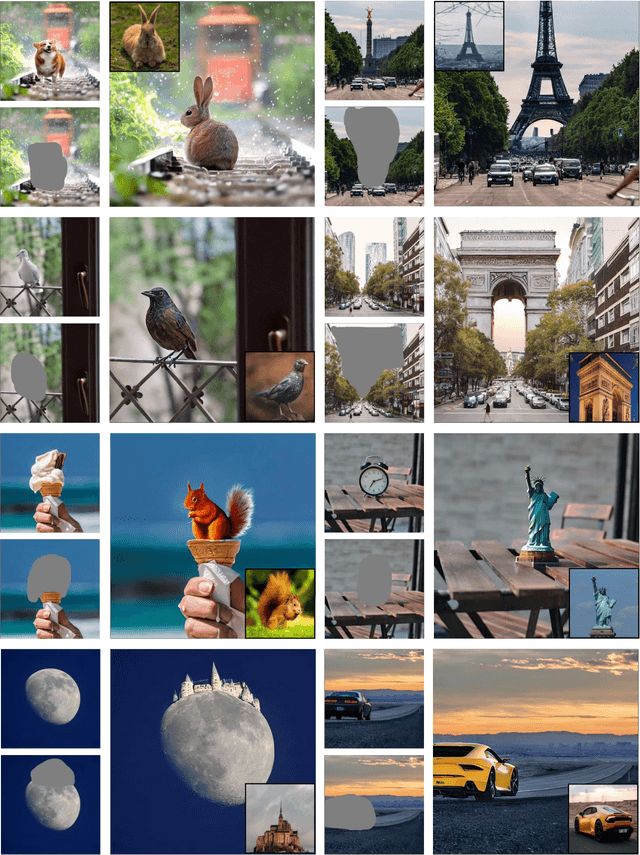
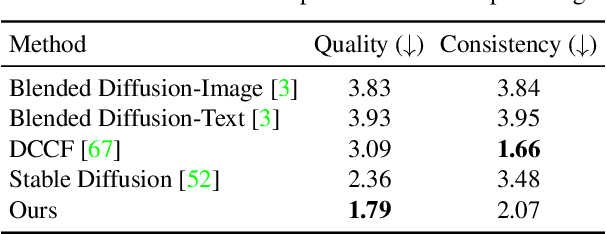

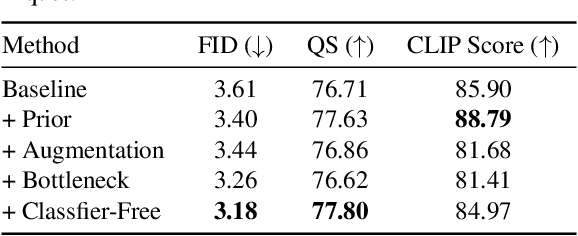
Abstract:Language-guided image editing has achieved great success recently. In this paper, for the first time, we investigate exemplar-guided image editing for more precise control. We achieve this goal by leveraging self-supervised training to disentangle and re-organize the source image and the exemplar. However, the naive approach will cause obvious fusing artifacts. We carefully analyze it and propose an information bottleneck and strong augmentations to avoid the trivial solution of directly copying and pasting the exemplar image. Meanwhile, to ensure the controllability of the editing process, we design an arbitrary shape mask for the exemplar image and leverage the classifier-free guidance to increase the similarity to the exemplar image. The whole framework involves a single forward of the diffusion model without any iterative optimization. We demonstrate that our method achieves an impressive performance and enables controllable editing on in-the-wild images with high fidelity.
Semantics-Preserving Sketch Embedding for Face Generation
Nov 23, 2022Abstract:With recent advances in image-to-image translation tasks, remarkable progress has been witnessed in generating face images from sketches. However, existing methods frequently fail to generate images with details that are semantically and geometrically consistent with the input sketch, especially when various decoration strokes are drawn. To address this issue, we introduce a novel W-W+ encoder architecture to take advantage of the high expressive power of W+ space and semantic controllability of W space. We introduce an explicit intermediate representation for sketch semantic embedding. With a semantic feature matching loss for effective semantic supervision, our sketch embedding precisely conveys the semantics in the input sketches to the synthesized images. Moreover, a novel sketch semantic interpretation approach is designed to automatically extract semantics from vectorized sketches. We conduct extensive experiments on both synthesized sketches and hand-drawn sketches, and the results demonstrate the superiority of our method over existing approaches on both semantics-preserving and generalization ability.
Explicitly Controllable 3D-Aware Portrait Generation
Sep 20, 2022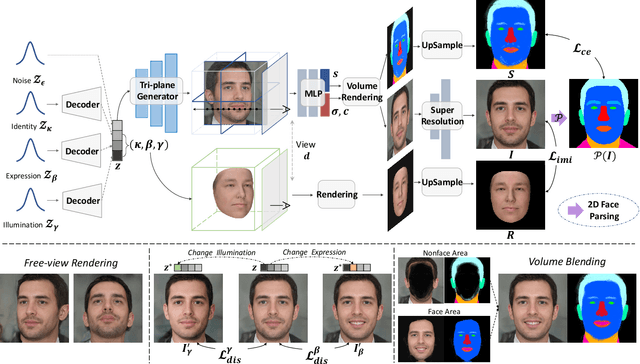
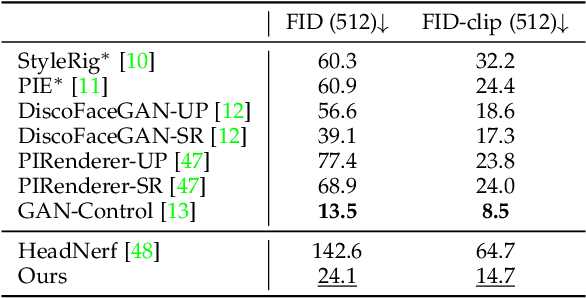
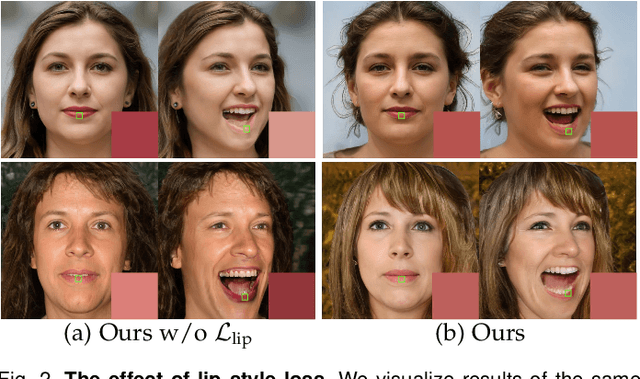
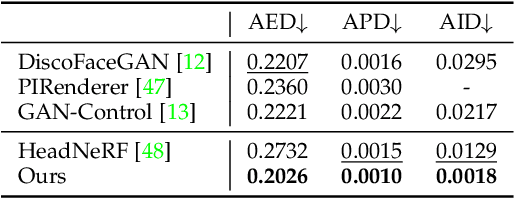
Abstract:In contrast to the traditional avatar creation pipeline which is a costly process, contemporary generative approaches directly learn the data distribution from photographs. While plenty of works extend unconditional generative models and achieve some levels of controllability, it is still challenging to ensure multi-view consistency, especially in large poses. In this work, we propose a network that generates 3D-aware portraits while being controllable according to semantic parameters regarding pose, identity, expression and illumination. Our network uses neural scene representation to model 3D-aware portraits, whose generation is guided by a parametric face model that supports explicit control. While the latent disentanglement can be further enhanced by contrasting images with partially different attributes, there still exists noticeable inconsistency in non-face areas, e.g., hair and background, when animating expressions. Wesolve this by proposing a volume blending strategy in which we form a composite output by blending dynamic and static areas, with two parts segmented from the jointly learned semantic field. Our method outperforms prior arts in extensive experiments, producing realistic portraits with vivid expression in natural lighting when viewed from free viewpoints. It also demonstrates generalization ability to real images as well as out-of-domain data, showing great promise in real applications.
DeepFacePencil: Creating Face Images from Freehand Sketches
Aug 31, 2020



Abstract:In this paper, we explore the task of generating photo-realistic face images from hand-drawn sketches. Existing image-to-image translation methods require a large-scale dataset of paired sketches and images for supervision. They typically utilize synthesized edge maps of face images as training data. However, these synthesized edge maps strictly align with the edges of the corresponding face images, which limit their generalization ability to real hand-drawn sketches with vast stroke diversity. To address this problem, we propose DeepFacePencil, an effective tool that is able to generate photo-realistic face images from hand-drawn sketches, based on a novel dual generator image translation network during training. A novel spatial attention pooling (SAP) is designed to adaptively handle stroke distortions which are spatially varying to support various stroke styles and different levels of details. We conduct extensive experiments and the results demonstrate the superiority of our model over existing methods on both image quality and model generalization to hand-drawn sketches.
 Add to Chrome
Add to Chrome Add to Firefox
Add to Firefox Add to Edge
Add to Edge